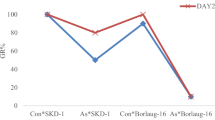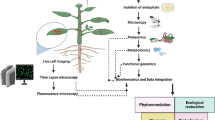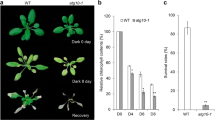Abstract
The proliferation of protein abundances under influence of seasonal changes are involved in cellular plant metabolic pathways. The protein profiles in relevant with seasonal variations in Butea superba leaves collected in winter, summer and rainy season were evaluated by two-dimensional polyacrylamide gel electrophoresis coupled with a nanoflow liquid chromatography coupled to electrospray ionization quadrupoletime- of-flight tandem mass spectrometry. The 84 proliferated protein spots were sum up of total proteins, which were found in 3 season-collected plant leaves and were classified into 11 functional groups. Eight proteins which exhibited the alteration of abundant levels in different seasons were found involved in carbohydrate and energy metabolism, photosynthesis, secondary metabolism, stress, RNA metabolism, ROS scavenging and detoxifying, and protein destination and storage. There were 2 proteins exhibited obviously isozyme polypeptide sequences. The variable physiological status within the plant leaf might be influenced by the quantitative and qualitative proliferated protein presences with response to seasonal changes and thus allowing plant to survive during severe abiotic stresses during seasonal changes.
Similar content being viewed by others
Abbreviations
- 2-DE:
-
two-dimensional polyacrylamide gel electrophoresis
- ACN:
-
acetonitrile
- CHAPS:
-
3-[(3-Cholamidopropyl) dimethylammonio]-1-propanesulfonate
- Vh:
-
volthours
- MDHAR:
-
monodehydroascorbate peroxidase reductase
References
Ingkaninan, K., Temkitthawon, P., Chuenchom, K., Yuyaem, T., and Thongnoi, W., Screening for acetylcholinesterase inhibitory activity in plants used in Thai traditional rejuvenating and neurotonic remedies, J. Ethnopharmacol., 2003, vol. 89, pp. 261–264.
Cherdshewasart, W., Cheewasopit, W., and Picha, P., The differential anti-proliferation effect of white (Pueraria mirifica), red (Butea superba), and black (Mucuna collettii) Kwao Krua plants on the growth of MCF-7 cells, J. Ethnopharmacol., 2004, vol. 93, pp. 255–260.
Roengsumran, S., Petsom, A., Ngamrojanavanich, N., Rugsilp, T., Sittiwicheanwong, P., Khorphueng, P., Cherdshewasart, W., and Chaichantipyuth, C., Flavonoid and flavonoid glycoside from Butea superba Roxb. and their cAMP phosphodiesterase inhibitory activity, J. Sci. Res. Chula. Univ., 2000, vol. 25, pp. 169–176.
Ngamrojanavanich, N., Loontaisong, A., Pengpreecha, S., Cherdshewasart, W., Pornpakakul, S., Pudhom, K., Roengsumran, S., and Petsom, A., Cytotoxic constituents from Butea superba Roxb., J. Ethnopharmacol., 2007, vol. 109, pp. 354–358.
Porter, J.R. and Semenov, M.A., Crop responses to climatic variation, Philos. Trans. R. Soc., B., 2005, vol. 360, pp. 2021–2035.
Mitprasat, M., Roytrakul, S., Jiemsup, S., Boonseng, O., and Yokthongwattana, K., Leaf proteomic analysis in cassava (Manihot esculenta, Crantz) during plant development, from planting of stem cutting to storage root formation, Planta, 2011, vol. 233, pp. 1209–1221.
Donnelly, B.E., Madden, R.D., Ayoubi, P., Porter, D.R., and Dillwith, J.W., The wheat (Triticum aestivum L.) leaf proteome, Proteomics, 2005, vol. 5, pp. 1624–1633.
Bradford, M.M., A rapid and sensitive method for the quantitation of microgram quantities of protein utilizing the principle of protein–dye binding, Anal. Biochem., 1976, vol. 72, pp. 248–254.
Srisomsap, C., Sawangareetrakul, P., Subhasitanont, P., Chokchaichamnankit, D., Chiablaem, K., Bhudhisawasdi, V., Wongkham, S., and Svasti, J., Proteomic studies of cholangiocarcinoma and hepatocellular carcinoma cell secretomes, J. Biomed. Biotechnol., 2010, vol. 2010, p. 437143. doi 10.1155/2010/437143
Boonmee, A., Srisomsap, C., Chokchaichamnankit, D., Karnchanatat, A., and Sangvanich, P., A proteomic analysis of Curcuma comosa Roxb. rhizomes, Proteome Sci., 2011, vol. 9, p. 43. doi 10.1186/1477-5956-9-43
Li, Q., Huang, J., Liu, S., Li, J., Yang, X., Liu, Y., and Liu, Z., Proteomic analysis of young leaves at three developmental stages in an albino tea cultivar, Proteome Sci., 2011, vol. 9, p. 44. doi 10.1186/1477-5956-9-44
Rasineni, G.K., Chinnaboina, M., and Reddy, A.R., Proteomic approach to study leaf proteins in a fastgrowing tree species, Gmelina arborea Linn. Roxb., Trees, 2009, vol. 24, pp. 129–138.
Zhang, Y., Xu, L., Zhu, X., Gong, Y., Xiang, F., Sun, X., and Liu, L., Proteomic analysis of heat stress response in leaves of radish (Raphanus sativus L.), Plant Mol. Biol. Rep., 2012, vol. 31, pp. 195–203.
Janmohammadi, M., Zolla, L., and Rinalducci, S., Low temperature tolerance in plants: changes at the protein level, Phytochemistry, 2015, vol. 117, pp. 76–89.
Ma, R., Sun, L., Chen, X., Jiang, R., Sun, H., and Zhao, D., Proteomic changes in different growth periods of ginseng roots, Plant Physiol. Biochem., 2013, vol. 67, pp. 20–33.
Veitch, N.C., Isoflavonoids of the Leguminosae, Nat. Prod. Rep., 2013, vol. 30, pp. 988–1027.
Grimplet, J., Wheatley, M.D., Jouira, H.B., Deluc, L.G., Cramer, G.R., and Cushman, J.C., Proteomic and selected metabolite analysis of grape berry tissues under well-watered and water-deficit stress conditions, Proteomics, 2009, vol. 9, pp. 2503–2528.
Komatsu, S. and Hossain, Z., Organ-specific proteome analysis for identification of abiotic stress response mechanism in crop, Front. Plant Sci., 2013, vol. 4, p. 71. doi 10.3389/fpls.2013.00071
Cherdshewasart, W. and Sutjit, W., Correlation of antioxidant activity and major isoflavonoid contents of the phytoestrogen-rich Pueraria mirifica and Pueraria lobata tubers, Phytomedicine, 2008, vol. 15, no. 1–2, pp. 38–43.
Lu, P., Sang, W.G., and Ma, K.P., Differential responses of the activities of antioxidant enzymes to thermal stresses between two invasive Eupatorium species in China, J. Integr. Plant Biol., 2008, vol. 50, no. 4, pp. 393–401.
Ciuzan, O., Lazar, S.L., Lung, M.L., Pop, O.L., and Pamfil, D., Involvement of the glycine-rich RNAbinding proteins (GRP) in osmotic stress response during seed germination: a comparison between GRP 2 and GRP 7, Med. Cluj-Napoca Hortic., 2015, vol. 72, pp. 61–67.
Kim, J.Y., Kim, W.Y., Kwak, K.J., Oh, S.H., Han, Y.S., and Kang, H., Glycine-rich RNA-binding proteins are functionally conserved in Arabidopsis thaliana and Oryza sativa during cold adaptation process, J. Exp. Bot., 2010, vol. 61, pp. 2317–2325.
Huang, Z., Hong, Q., Xue, P., Paul, G., Feng, Z., Wang, L., Mei, Y., Wu, L., Chen, X., and Wu, D., A proteome-wide screen identifies valosin-containing protein as an essential regulator of podocyte endoplasmic reticulum stress, Chin. Sci. Bull., 2012, vol. 57, pp. 2493–2505.
Genschik, P., Jamet, E., Philipps, G., Parmentier, Y., Gigot, C., and Fleck, J., Molecular characterization of a ß-type proteasome subunit from Arabidopsis thaliana co-expressed at a high level with an a-type proteasome subunit early in the cell cycle, Plant J., 1994, vol. 6, pp. 537–546.
de Oliveira, A.B., Alencar, N.L.M., and Gomes-Filho, E., Comparison between the water and salt stress effects on plant growth and development, in Responses of Organisms to Water Stress, Akinci, S., Ed., Rijeka: InTech, 2013, pp. 67–94.
Gill, S.S. and Tuteja, N., Reactive oxygen species and antioxidant machinery in abiotic stress tolerance in crop plants, Plant Physiol. Biochem., 2010, vol. 48, pp. 909–930.
Author information
Authors and Affiliations
Corresponding author
Additional information
The article is published in the original.
Electronic supplementary material: The online version of this article contains supplementary material, which is available to authorized users.
Electronic supplementary material
Rights and permissions
About this article
Cite this article
Leelahawong, C., Srisomsap, C., Cherdshewasart, W. et al. Proteomic analysis of isozymes in Butea superba leaves. Russ J Plant Physiol 64, 100–108 (2017). https://doi.org/10.1134/S1021443717010101
Received:
Published:
Issue Date:
DOI: https://doi.org/10.1134/S1021443717010101




